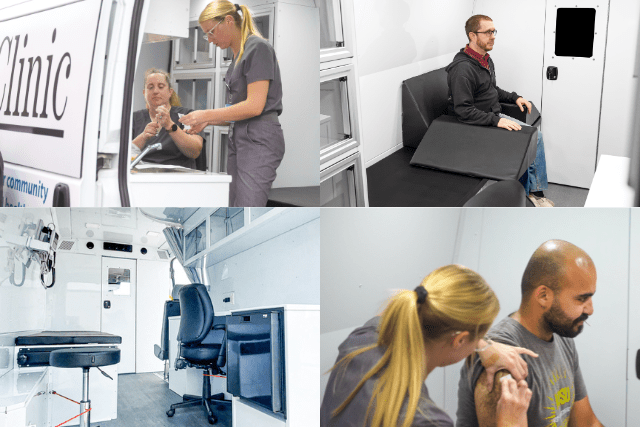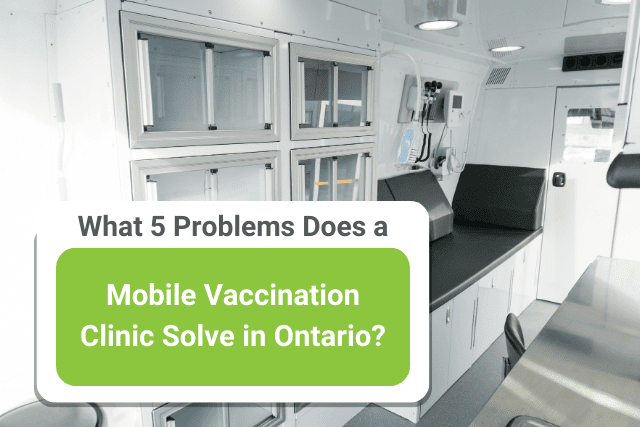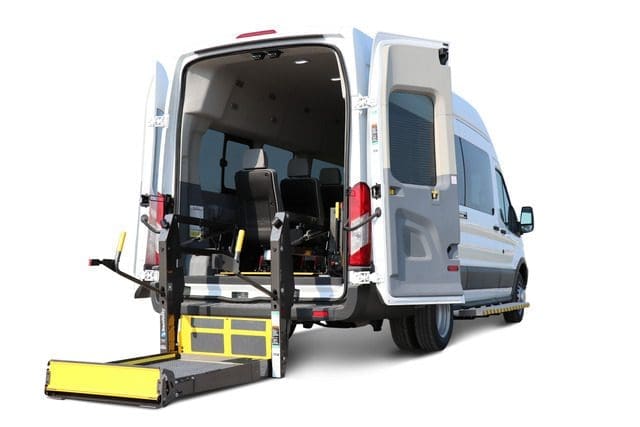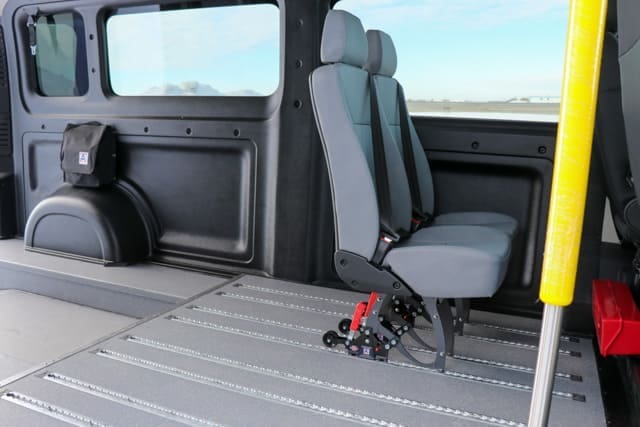Did you know Ontario recently faced a measles outbreak in Sudbury? Events like this show how fast illness can spread when vaccines aren’t accessible. If you’re part of a health network, non-profit, or municipality, you probably feel the pressure of reaching people who can’t easily travel. The gap grows wider in places like Northern Ontario, where long distances and limited transit make it tough for families to get care.
Without a mobile vaccination clinic in Ontario, more people miss shots, outbreaks spread faster, and communities stay vulnerable. That’s a lot of weight to carry, and it can feel frustrating when you want to protect your community but lack the tools.
At MoveMobility, we’ve been building accessible medical vehicles for over 20 years. Our team is Ford QVM and Stellantis QPro certified, and every vehicle has the National Safety Mark to meet strict Canadian safety standards. We take the time to listen and build vehicles that fit real-world needs, because every community is different. While we know we’re not the only manufacturer, our mission stays clear: to support your mission of saving lives.
In this article, you’ll learn about 5 problems a mobile vaccination clinic in Ontario solves:
- Rural and remote gaps
- Slow outbreak response
- Equity barriers
- Clinic overload
- Low trust
5 problems that a mobile vaccination clinic in Ontario solves

Running vaccination programs in Ontario can be tough. People live far apart, some neighborhoods have extra challenges, and healthcare teams are often stretched too thin. A mobile vaccination clinic in Ontario helps fix these problems by bringing vaccines right to the people who need them. From small towns up north to busy city streets, mobile vaccine clinics make getting vaccinated easier, faster, and fairer for everyone.
1. Limited access in remote areas
In many parts of Ontario, think far northern towns, remote First Nations reserves, or small communities along lakes and forests, people often live many hours away from a fixed vaccine clinic. That’s more than just an inconvenience. It’s a barrier that stops people from getting care. When there’s ice, snow, poor roads, or limited public transit, expecting someone to drive 2 or 3 hours just to get vaccinated is unrealistic. For your organization, that gap means missed opportunities, lower vaccination rates, and communities left vulnerable.
Data backs this up. In a study from Southeastern Ontario, vaccine coverage was over 10 % lower in materially deprived and rural areas compared to urban centres. And national data shows rural and remote communities often lag behind in immunization across Canada. This is the gap your mobile vaccination clinic in Ontario exists to solve.
A mobile vaccination clinic in Ontario brings the clinic to the people. Here’s how it helps:
- Travel time shrinks: Instead of people driving for hours, your mobile vaccine clinic reaches their town directly.
- Barrier removal: Bad roads, weather, or lack of transit won’t stop vaccinations when your vehicle can get closer.
- Higher uptake: When access is easy, more people show up.
- Better coverage in underserved places: Small towns that once were skipped now get served.
Imagine a mobile vaccination clinic visiting remote First Nations communities in the James Bay region. Elderly residents, often facing mobility or transport issues, no longer have to coordinate long trips. The clinic pulls right in near their community hall or reserve centre. Suddenly, vaccination becomes feasible.
Your mission is to protect and care for all people in Ontario. Geography should never be the reason someone misses a shot.
2. Slow outbreak response times
When a new case of measles, influenza, or another contagion flares up in Ontario, time is everything. Fixed vaccine sites often take days or even weeks to ramp up. Appointments must be booked. Clinics must staff up. In contrast, a mobile vaccination clinic in Ontario can move quickly into hotspots, bringing vaccines directly to communities before an outbreak spreads further.
This slow response gap is risky. In southwestern Ontario, a measles outbreak recently saw over 2,000 cases and put a strain on public health systems. By the time some clinics opened, infections had spread to more vulnerable people who couldn’t travel easily. Delays like this allow viruses to leap across townships, infecting those who were just out of reach.
Here’s how a mobile vaccine clinic fills the gap:
- Rapid deployment: You drive into the area where cases are rising the same day.
- On-demand presence: No need to wait for clinics to get staffed or set up.
- Pop-up coverage: You can station the mobile clinic temporarily, say in schools, community centres, or local halls.
- Flexible routes: You adjust your schedule daily based on case data.
Let’s imagine this in action: An outbreak starts in a county near Kitchener. Instead of asking your citizens to travel to Waterloo or Guelph, your mobile vaccination clinic arrives in Elmira within 24 hours. You park next to the community centre, people can walk or book a short ride, and doses go in arms without delay.
This approach helps you curb the spread fast. It protects vulnerable folks in that county who might otherwise be exposed because they lacked access or couldn’t wait. The result? You stop growth chains early, ease pressure on hospitals and public health, and strengthen trust in your organization’s ability to respond.
3. Equity barriers
In Ontario, not everyone has the same chance to get vaccinated. People in low-income neighbourhoods, new immigrant communities, and those without stable housing often face bigger hurdles. For them, even small challenges like taking two buses, missing a shift at work, or finding childcare can mean they skip a vaccine altogether. That gap shows up in the numbers, where vaccination rates in disadvantaged areas consistently fall behind wealthier regions.
A mobile vaccination clinic in Ontario helps break down those barriers. Instead of asking people to come to you, you show up where they already are. That can mean setting up outside a busy housing complex in Scarborough, visiting a shelter in downtown Ottawa, or parking near a food bank in Hamilton. By being present in familiar places, your clinic makes the process less intimidating and more accessible.
Here’s how mobile vaccine clinics create equity:
- Closer reach: You bring vaccines into neighbourhoods where public health coverage is low.
- Lower costs: People don’t have to lose wages or pay for transit.
- Stronger trust: When services meet people where they are, they feel respected.
- Language-friendly settings: Staff can partner with community groups to support multiple languages.
Think of a single mom in Windsor working two jobs. She doesn’t have time to take her kids across the city to a fixed clinic. But when your vaccine mobile clinic parks at the community centre down the street, she can stop by after work, and everyone gets vaccinated in minutes.
This is what equity looks like in practice. When those daily barriers don’t exist, a mobile vaccination clinic turns “maybe someday” into “today.”
4. Clinic overload
If you’ve ever walked into a vaccine clinic in Ontario during flu season, you know the feeling. Long lines, crowded waiting rooms, and tired staff trying to keep up. When demand spikes, fixed sites struggle to manage the flow. People wait too long, some leave before getting a shot, and staff burnout grows. This overload hurts everyone.
A mobile vaccination clinic in Ontario eases that pressure by spreading the load. Instead of funneling thousands of people into a handful of static clinics, vaccine mobile clinics can pop up across the city or region. Imagine Peel Region during a heavy flu season. Instead of every resident heading to Brampton Civic or Mississauga’s health centre, mobile units set up in church parking lots or school gyms. Suddenly, the system feels manageable again.
How a mobile vaccine clinic helps reduce overload:
- Fewer bottlenecks: More sites means fewer people per clinic
- Shorter wait times: Faster flow keeps people from leaving unvaccinated
- Staff relief: Mobile teams handle part of the volume, so fixed staff aren’t overwhelmed
- Better community reach: You don’t just manage numbers, you expand coverage
Picture Toronto Public Health trying to keep up with demand in Scarborough. A COVID vaccination mobile clinic pulls into a mall lot, adding hundreds of extra doses in a single day. That one move keeps lines down at nearby hospitals and keeps the staff inside from burning out.
Clinic overload is a real challenge in Ontario, but vaccine mobile clinics act like a relief valve. They keep the system moving, protect staff morale, and make sure more people leave protected instead of frustrated.
5. Trust
Trust is fragile, especially when it comes to vaccines in Ontario. Some people have faced long waits at health centres or turned up only to find appointments canceled. Others in Indigenous or newcomer communities may remember times when care felt rushed or decisions were made without their input. These experiences leave lasting marks. When people feel ignored or unheard, their confidence in the system fades.
A mobile vaccination clinic in Ontario can begin to repair that confidence. Showing up in a neighbourhood signals something powerful: Care that comes to your patients, not the other way around. It tells families that their time, their comfort, and their safety matter. That simple action often carries more weight than another flyer or press release.
Ways vaccine mobile clinics rebuild trust:
- Visible presence: People see healthcare arriving in their own community.
- Familiar spaces: Clinics set up at schools, churches, or community halls feel welcoming.
- Local voices: Working with neighbourhood leaders adds comfort and credibility.
- Consistency: Returning to the same places shows commitment that lasts beyond one visit.
Picture a small community outside Sudbury where families feel disconnected from big-city decisions. When a mobile vaccine clinic sets up near the local rink, residents see healthcare woven into their daily lives. It feels personal and respectful, not distant or impersonal.
Trust grows slowly, but each visit builds a stronger bridge. Mobile vaccinations show that people are valued where they are, which can turn hesitation into participation and eventually into lasting confidence in care.
Case study: Ontario’s GO-VAXX mobile vaccine clinics
During the height of the pandemic, Ontario knew not everyone could make it to a hospital or community center for their shot. The answer? Put the clinic on wheels.
How did it work?
Metrolinx teamed up with the Ministry of Health to retrofit GO Transit buses into mobile vaccine clinics. Inside, they added:
- Refrigeration for vaccines
- Privacy areas for patients
- Trained medical staff and intake space
- Accessibility features for people with mobility challenges
These buses rolled into malls, small towns, workplaces, and even special events, meeting people where they were.
- Convenience: No need to figure out a ride or wait in line at a big clinic.
- Flexibility: Buses could pivot quickly to areas with low vaccine rates.
- Trust: Familiar, local settings made the experience less intimidating.
- Equity: Removed transportation barriers for seniors, families, and rural residents.
What were the results?
In just one weekend, a GO-VAXX bus vaccinated more than 150 people, and nearly half were getting their very first dose. That’s the kind of impact that happens when care goes mobile.
Now, here’s the kicker: You don’t need a full-sized bus to make this work. The same setup can be built on a van chassis, which is:
- Cheaper to purchase and outfit
- Easier to drive and park in tight city streets or rural roads
- Faster to deploy for pop-up clinics
Ontario’s GO-VAXX buses proved the model works. Van-based mobile vaccine clinics make the concept even more practical for health systems, municipalities, and outreach programs looking to serve communities without the overhead of running a bus fleet.
Ready to take the next step with a mobile vaccination clinic in Ontario?
You likely came here because you’ve seen some people’s challenges in getting vaccinations in Ontario. Those are real problems, and they weigh heavily on organizations like yours.
After reading this article, you’ve learned how a mobile vaccination clinic in Ontario can:
- Close access gaps for rural and northern towns
- Respond faster to outbreaks across the province
- Support equity in underserved neighbourhoods
- Relieve clinic overload during busy seasons
- Build trust through presence and consistency
For over two decades, MoveMobility has been building vehicles that make healthcare mobile across Canada. Our work doesn’t stop at handing over the keys. We partner with your team to design, launch, and support programs that reach people where they live. From Prince Edward Island’s east coast to British Columbia’s west coast, our vehicles help organizations deliver care with dignity and compassion. We’re leaders in this field because we listen first, build with care, and stand beside you for the long run. If you have questions, click the button below to talk to a mobility expert today.
If you’re not ready to talk to a mobility expert yet, here are a few resources to guide you further:
1. How much does a mobile medical van cost in 2025? a clear breakdown of what to budget when planning your unit.
2. 5 steps to buying a mobile medical van: A step-by-step guide for organizations preparing to move forward.
3. 7 ways that mobile medical vans break down healthcare barriers: Insight into how mobile care creates long-term impact beyond vaccinations.





